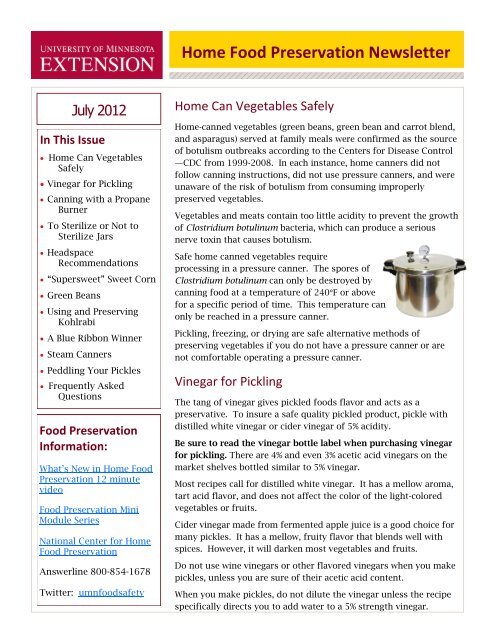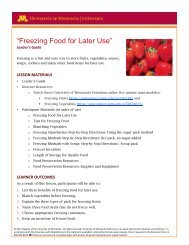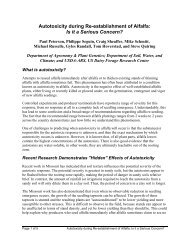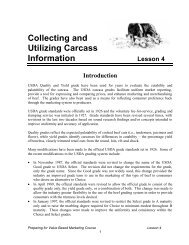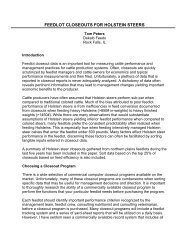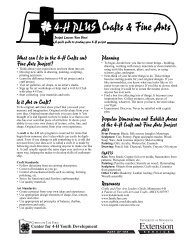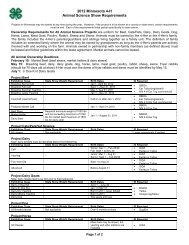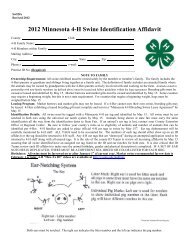Home Food Preservation Newsletter - University of Minnesota ...
Home Food Preservation Newsletter - University of Minnesota ...
Home Food Preservation Newsletter - University of Minnesota ...
You also want an ePaper? Increase the reach of your titles
YUMPU automatically turns print PDFs into web optimized ePapers that Google loves.
Canning with a Propane BurnerIt’s tempting to move thepressure canner outsidewhen it’s hot inside orwhen you don’t want touse your canner on thesmooth-top stove. If youconsider using a propaneburner for canning, it isimportant to know thatthere is a safety issue.The makers <strong>of</strong> Presto and National cannersstate: “Caution: Do not use pressure canneron an outdoor LP gas burner or gas rangeover 12,000 BTU’s.” Their customer servicedepartment also does not recommend usingany (new or old) model Pressure Canners onLP gas burners over 12,000 BTU’s.The main reason is that the high heat candamage pressure canners, especially thenewer and thinner aluminum versions. Thedamage can range from simple warping tosevere warping (where the lid might detach)to fusing <strong>of</strong> the aluminum canner to the LPstove. Damage can also result from boilingout the canning water too quickly. If acanner goes dry, it probably will warp.If you do need to use a pressure canneroutside, use a high-quality camp stove, makesure the canner fits the burner, be sure theburner and range are level, pay closeattention to the temperature, stay away frombreezes, and make sure you have enoughwater in the canner.To Sterilize or Not to Sterilize JarsSterilize jars that will be used for jams, jelliesand pickled products when they areprocessed less than 10 minutes. To sterilize,place empty jars right-side-up on the rack ina boiling-water canner. Fill the canner andjars with hot (not boiling) water to one inchabove the tops <strong>of</strong> the jars. Boilapproximately 10-15 minutes. Remove thehot, sterilized jars one at a time and drain.Save the hot water for processing filled jars.Fill jars with food, top with lids and ringsand process as directed.Jars used for foods that will be processed ina pressure canner or in a boiling-watercanner for 10 minutes or longer, should beclean but do not need to be sterilized.Headspace RecommendationsThe amount <strong>of</strong> space to leave at the top <strong>of</strong>the jar is determined by the type <strong>of</strong> foodbeing canned. When jars are overfilled, thecontents may boil out during the processingand cause solids or seeds to be caught underthe sealing compound and prevent an airtightseal from forming.When too much headspace is left at the top<strong>of</strong> the jar, the processing time may not belong enough to drive out all the extra air,thus preventing an airtight seal. Excess airinside the jar also causes food discoloration.<strong>Food</strong>FruitsJuicesTomatoesVegetablesJams/JelliesMeatsPoultryHeadspace½ inch¼ inch½ inch1 inch¼ inch1 inch1 ¼ inch
“Supersweet” Sweet CornNew varieties <strong>of</strong>sweet corn aresometimesreferred to as“supersweet” corn.They contain morenatural sugarsthan the older, traditional varieties. Thenatural sugars also seem to improve thekeeping quality <strong>of</strong> sweet corn. As a result,some people freeze the supersweet cornwithout blanching and still have anacceptable product. For longer storage (morethan 4 months), it is still best to blanch thecorn so it will not have an <strong>of</strong>f-flavor.If you are canning supersweet sweet corn, thecorn’s extra sugar makes it difficult toprevent it from turning brown. The sugars inthe corn caramelize at the high temperaturesat which corn is processed in the pressurecanner. If you used proper canning methods,the corn is safe to eat although it may have abrown color.When canning corn, you may end up with abetter quality product if you use a less sweetvariety and use the supersweet sweet cornfor freezing.Green BeansGreen beans are one <strong>of</strong>the most popular grownvegetables in the home gardenand one <strong>of</strong> the most popular preservedvegetables. When canning green beans,remember it is not safe to process beans in aboiling water bath, not even for long periods<strong>of</strong> time. The only safe method <strong>of</strong> processinggreen beans is to process them for therecommended amount <strong>of</strong> time in a pressurecanner:http://nchfp.uga.edu/how/can_04/beans_snap_italian.htmlFreezing is an easy way to preserve greenbeans:http://nchfp.uga.edu/how/freeze/bean_green.html. We also like to use the individualquick freezing method <strong>of</strong> placing blanchedbeans on a tray to freeze before packingthem in packages. This makes it easier totake the amount needed from the packageand the beans cook more quickly.Pickled Dill Beans adds an interestingaddition to a meal:http://nchfp.uga.edu/how/can_06/dilled_beans.html.Dried green beans are handy to haveavailable when making soups and hot dishes:http://nchfp.uga.edu/publications/uga/uga_dry_fruit.pdf.Using and Preserving KohlrabiAnother name for Kohlrabi is “turnipcabbage”. The flavor is similar to a turnip.Because <strong>of</strong> the sprouts coming out <strong>of</strong> thebulb, it appears to be a creature from outerspace. Kohlrabi can be cut into strips andeaten raw, tossed into salads, stir-fried, orsteamed and served with a cheese sauce. It’salso used in soups, added to coleslaw orpotato hot dishes.For short term use, remove the leaves andstore in a perforated plastic bag in therefrigerator crisper for approximately a week.To freeze kohlrabi, blanch slices or 1/2–inchcubes for 1 minute, cool, drain and freeze.Another idea: after blanching, spread ontrays for quick-freezing and package infreezer bags or containers to add to soups orhot dishes.Canning kohlrabi is not recommendedbecause it develops a strong flavor andusually discolors when canned.
A Blue Ribbon WinnerWhen visiting a county fair, thecolorful jars <strong>of</strong> home cannedfruits and vegetables with a proudblue, red or white ribbon displayedmay have caught your eye.Have you ever thought about entering yoursalsa, dill pickles or strawberry jam in thefair? If so, contact your local fair boardsecretary to receive a fair book or premiumlist. This listing gives the requirements youwill need to know and follow to exhibit. Forcounty fair and state fair exhibitorinformation view:www.mfcf.com/members.htm andhttp://z.umn.edu/statefair.You may have a blue ribbon winner!Steam Canners“Steam canners are notrecommended becauseprocessing times for use withcurrent models have not beenadequately researched.”–National Center for <strong>Home</strong> <strong>Food</strong><strong>Preservation</strong>Good News! Research on processing andpreserving food safely with a steam canner isbeginning this fall at the <strong>University</strong> <strong>of</strong>Wisconsin in collaboration with the<strong>University</strong> <strong>of</strong> Georgia. Stay tuned!Peddling Your PicklesDo you make crisp tangy dill pickles? Doyour friends rave about your homemadesalsa? Have you thought about marketingyour home canned products at a Farmers’Market?If so, learn about the guidelines for<strong>Minnesota</strong>’s “Pickle Bill” and OperationalGuidelines for Vendors at the Farmers’Market at http://z.umn.edu/mda.Frequently Asked QuestionsWhy does a jar break?Jars break because <strong>of</strong> stress created bybumping or hitting jars with an object orfrom temperature extremes. Use a plasticutensil instead <strong>of</strong> a metal table knife toremove air bubbles from jars. The tapping <strong>of</strong>the metal knife can stress the bottom <strong>of</strong> thejar causing the bottom to fall out. Otherreasons for breakage include usingcommercial food jars rather than jarsmanufactured for home canning; using jarsthat have hairline cracks; placing jars directlyon the bottom <strong>of</strong> the canner instead <strong>of</strong> on arack; putting hot food in cold jars; or puttingjars <strong>of</strong> raw or unheated food directly intoboiling water in the canner.Are there any safe methods for makingherb flavored oils?Herbs and oils are both low-acid and togethercould support the growth <strong>of</strong> disease-causingClostridium botulinum bacteria. Oils may beflavored with fresh or dried herbs if they aremade up for fresh use or stored in therefrigerator and used within 4 days. Thereare no canning recommendations.How long will food remain frozen if thepower goes <strong>of</strong>f?<strong>Food</strong> in a full freezer will usually stay frozen2 to 4 days. A half-filled freezer will keepfood frozen only about 24 hours.---------------------If you would like to stop receiving the <strong>Home</strong> <strong>Food</strong><strong>Preservation</strong> newsletter, please emailschmi374@umn.edu.For more food safety information visit our website:www1.extension.umn.edu/food-safety/.© 2011, Regents <strong>of</strong> the <strong>University</strong> <strong>of</strong> <strong>Minnesota</strong>. <strong>University</strong> <strong>of</strong> <strong>Minnesota</strong> Extension is an equal opportunity educator and employer. In accordance with theAmericans with Disabilities Act, this publication/material is available in alternative formats upon request. Direct requests to the Extension Store at 800-876-8636.Printed on recycled and recyclable paper with at least 10 percent postconsumer waste material.


